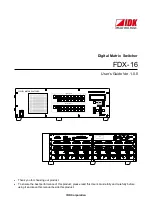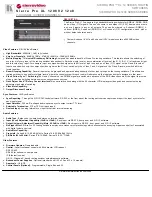
OPERATION
1. Plug your tool into the receptacle (Fig. 1 - 1) at the end of the foot pedal power cord.
2. Plug the foot pedal power cord into a grounded outlet.
3. Switch your tool ON to prepare it to be used with the foot pedal switch.
NOTE:
Turning your tool
ON at this point will not start the tool.
4. Simply press down on the foot pedal to turn your tool ON and release the foot pedal to turn your
tool OFF.
5. Turn your tool OFF whenever leaving your work area or after finishing a project.
ELECTRICAL INFORMATION
INSTRUCTION MANUAL
AMPERAGE
REQUIRED GAUGE FOR EXTENSION CORDS
25 ft.
50 ft.
100 ft.
150 ft.
10A
18 gauge
16 gauge
14 gauge
12 gauge
GROUNDING INSTRUCTIONS
In the event of a malfunction or breakdown, grounding provides the
path of least resistance for an electric current and reduces the risk
of electric shock. This tool is equipped with an electric cord that has
an equipment grounding conductor and a grounding plug. The plug
MUST be plugged into a matching outlet that is properly installed
and grounded in accordance with ALL local codes and ordinances.
1. Do not modify the plug provided.
If it will not fit the outlet,
have the proper outlet installed by a licensed electrician.
1. Examine extension cord before use.
Make sure your extension cord is properly wired and in
good condition. Always replace a damaged extension cord or have it repaired by a qualified
person before using it.
2. Do not abuse extension cord.
Do not pull on cord to disconnect from receptacle; always
disconnect by pulling on plug. Disconnect the extension cord from the receptacle before
disconnecting the product from the extension cord. Protect your extension cords from sharp
objects, excessive heat and damp/wet areas.
3. Use a separate electrical circuit for your tool.
This circuit must not be less than a 12-gauge
wire and should be protected with a 15A time-delayed fuse. Before connecting the motor to the
power line, make sure switch is in the OFF position and the electric current is rated the same as
the current stamped on the motor nameplate. Running at a lower voltage will damage the motor.
Fig. 2
2. Improper connection
of the equipment grounding conductor can result in electric shock. The
conductor with the green insulation (with or without yellow stripes) is the equipment grounding
conductor. If repair or replacement of the electric cord or plug is necessary, DO NOT connect the
equipment grounding conductor to a live terminal.
3. Check
with a licensed electrician or service personnel if you do not completely understand the
grounding instructions or whether the tool is properly grounded.
4. Use only three-wire extension cords
that have three-pronged plugs and outlets that accept the
tool’s plug. Repair or replace a damaged or worn cord immediately.
CAUTION!
In all cases, make certain the outlet in question is properly grounded. If you are not sure,
have a licensed electrician check the outlet.
GUIDELINES AND RECOMMENDATIONS FOR EXTENSION CORDS
When using an extension cord, be sure to use one heavy enough to carry the current your product will
draw. An undersized cord will cause a drop in line voltage resulting in loss of power and overheating.
The table below shows the correct size to be used according to cord length and ampere rating. When
in doubt, use a heavier cord. The smaller the gauge number, the heavier the cord.
WARNING!
Do not use with equipment rated for more than 10A.
ELECTRICAL SAFETY WARNINGS
1. Power tool plugs must match the outlet.
Never modify the plug in any way. Do not use any
adapter plugs with earthed (grounded) power tools. Unmodified plugs and matching outlets will
reduce risk of electric shock.
2. Avoid body contact with earthed or grounded surfaces
such as pipes, radiators, ranges and
refrigerators. There is an increased risk of electric shock if your body is earthed or grounded.
3. Do not expose power tools to rain or wet conditions.
Water entering a power tool will increase
the risk of electric shock.
4. Do not abuse the cord.
Never use the cord for carrying, pulling or unplugging the power tool.
Keep cord away from heat, oil, sharp edges or moving parts. Damaged or entangled cords
increase the risk of electric shock.
5. When operating a power tool outdoors,
use an extension cord suitable for outdoor use. Use of
a cord suitable for outdoor use reduces the risk of electric shock.
6. If operating the power tool in a damp location is unavoidable,
use a Ground Fault Circuit
Interrupter (GFCI) protected supply. Use of a GFCI reduces the risk of electric shock.
1
Fig. 1




















